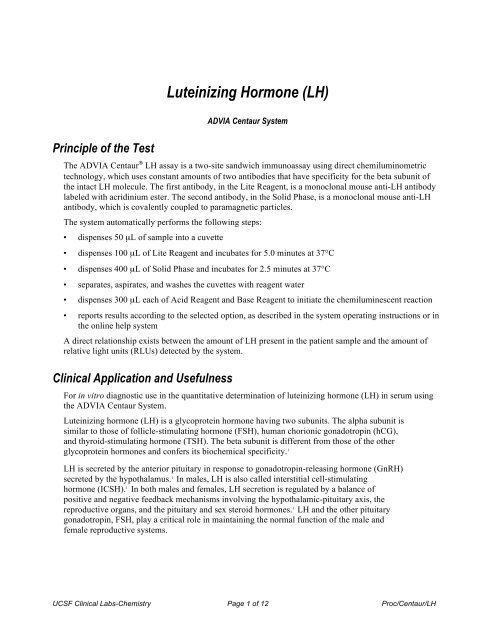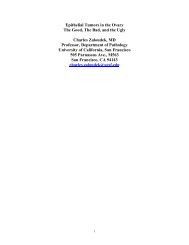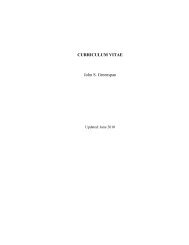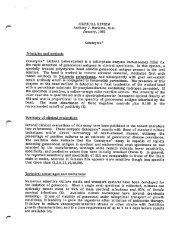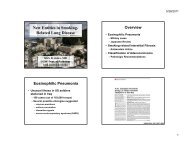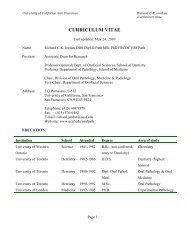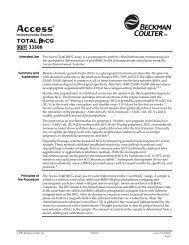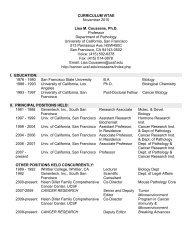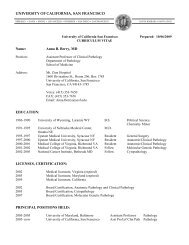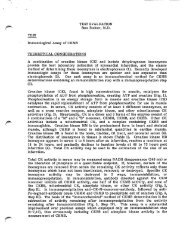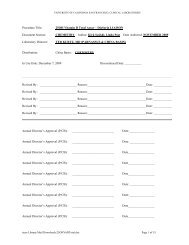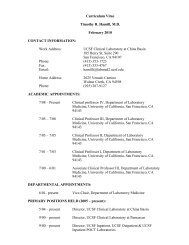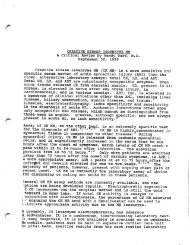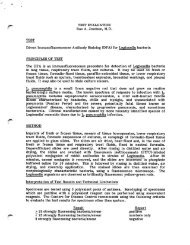Luteinizing Hormone (LH)
Luteinizing Hormone (LH)
Luteinizing Hormone (LH)
You also want an ePaper? Increase the reach of your titles
YUMPU automatically turns print PDFs into web optimized ePapers that Google loves.
Principle of the Test<br />
<strong>Luteinizing</strong> <strong>Hormone</strong> (<strong>LH</strong>)<br />
ADVIA Centaur System<br />
The ADVIA Centaur ® <strong>LH</strong> assay is a two-site sandwich immunoassay using direct chemiluminometric<br />
technology, which uses constant amounts of two antibodies that have specificity for the beta subunit of<br />
the intact <strong>LH</strong> molecule. The first antibody, in the Lite Reagent, is a monoclonal mouse anti-<strong>LH</strong> antibody<br />
labeled with acridinium ester. The second antibody, in the Solid Phase, is a monoclonal mouse anti-<strong>LH</strong><br />
antibody, which is covalently coupled to paramagnetic particles.<br />
The system automatically performs the following steps:<br />
• dispenses 50 µL of sample into a cuvette<br />
• dispenses 100 µL of Lite Reagent and incubates for 5.0 minutes at 37°C<br />
• dispenses 400 µL of Solid Phase and incubates for 2.5 minutes at 37°C<br />
• separates, aspirates, and washes the cuvettes with reagent water<br />
• dispenses 300 µL each of Acid Reagent and Base Reagent to initiate the chemiluminescent reaction<br />
• reports results according to the selected option, as described in the system operating instructions or in<br />
the online help system<br />
A direct relationship exists between the amount of <strong>LH</strong> present in the patient sample and the amount of<br />
relative light units (RLUs) detected by the system.<br />
Clinical Application and Usefulness<br />
For in vitro diagnostic use in the quantitative determination of luteinizing hormone (<strong>LH</strong>) in serum using<br />
the ADVIA Centaur System.<br />
<strong>Luteinizing</strong> hormone (<strong>LH</strong>) is a glycoprotein hormone having two subunits. The alpha subunit is<br />
similar to those of follicle-stimulating hormone (FSH), human chorionic gonadotropin (hCG),<br />
and thyroid-stimulating hormone (TSH). The beta subunit is different from those of the other<br />
glycoprotein hormones and confers its biochemical specificity. 1<br />
<strong>LH</strong> is secreted by the anterior pituitary in response to gonadotropin-releasing hormone (GnRH)<br />
secreted by the hypothalamus. 1 In males, <strong>LH</strong> is also called interstitial cell-stimulating<br />
hormone (ICSH). 1 In both males and females, <strong>LH</strong> secretion is regulated by a balance of<br />
positive and negative feedback mechanisms involving the hypothalamic-pituitary axis, the<br />
reproductive organs, and the pituitary and sex steroid hormones. 1 <strong>LH</strong> and the other pituitary<br />
gonadotropin, FSH, play a critical role in maintaining the normal function of the male and<br />
female reproductive systems.<br />
UCSF Clinical Labs-Chemistry Page 1 of 12 Proc/Centaur/<strong>LH</strong>
Specimen Collection and Handling<br />
Specimen Collection<br />
BIOHAZARD<br />
All products or objects that come in contact with human or animal body fluids should<br />
be handled, before and after cleaning, as if capable of transmitting infectious diseases.<br />
Wear facial protection, gloves, and protective clothing.<br />
• Serum is the recommended sample type for this assay.<br />
• This assay requires 50 µL of sample for a single determination. Additional volume is required for<br />
onboard dilutions.<br />
• Allow samples to clot adequately before centrifugation.<br />
• Samples are free of fibrin or other particulate matter.<br />
• Samples are free of bubbles.<br />
Specimen Storage and Stability<br />
• Keep tubes covered and upright at all times.<br />
• Do not use samples that have been stored at room temperature for longer than 8 hours.<br />
• Tightly cover and refrigerate specimens at 2 to 8°C if the assay is not completed within 8 hours.<br />
• Freeze samples at or below -20°C if the sample is not assayed within 48 hours.<br />
• Freeze samples only once and mix thoroughly after thawing.<br />
Specimen Rejection Criteria<br />
Reagents<br />
Unlabelled specimens are rejected<br />
Grossly hemolyzed samples are rejected<br />
Storage and Stability<br />
• Store the reagents upright at 2–8 °C.<br />
• Primary reagents stable until the expiration date on the pack label, or for 28 days onboard the system.<br />
• Diluent stable until the expiration date on the pack label, or for 28 consecutive days after accessing<br />
the ancillary reagent pack.<br />
CAUTION:<br />
• Discard the primary reagent packs at the end of the onboard stability interval.<br />
UCSF Clinical Labs-Chemistry Page 2 of 12 Proc/Centaur/<strong>LH</strong>
• Do not use reagents beyond the expiration date.<br />
Ingredients<br />
Reagent ingredients for the ADVIA Centaur <strong>LH</strong> assay are as follows:<br />
Reagent Volume Ingredients<br />
Lite Reagent 6.0 mL/ReadyPack ®<br />
monoclonal mouse anti-<strong>LH</strong> antibody (~0.17 µg/mL)<br />
labeled with acridinium ester in buffer with sodium<br />
azide (< 0.1%) and preservatives<br />
Solid Phase 24.0 mL/ReadyPack monoclonal mouse anti-<strong>LH</strong> antibody (~0.05 mg/mL)<br />
covalently coupled to paramagnetic particles in buffer<br />
with sodium azide (0.1%) and preservatives<br />
Multi-Diluent 1 25.0 mL/ReadyPack equine serum with sodium azide (0.1%) and<br />
preservatives<br />
WARNING: Sodium azide can react with copper and lead plumbing to form explosive metal azides. On<br />
disposal, flush reagents with a large volume of water to prevent the buildup of azides, if disposal into a<br />
drain is in compliance with federal, state, and local requirements.<br />
BIOHAZARD<br />
All products or objects that come in contact with human or animal body fluids should<br />
be handled, before and after cleaning, as if capable of transmitting infectious diseases.<br />
Wear facial protection, gloves, and protective clothing.<br />
Reagents Special Preparation<br />
No special preparation of reagents is required.<br />
Calibration<br />
For detailed procedural information about scheduling a calibration, refer to the ADVIA Centaur<br />
Reference Manual or to the online help system.<br />
Two-point Calibration Interval<br />
Use Calibrator B to perform two-point calibrations.<br />
Perform a two-point calibration every 28 days. Additionally, calibrate when the following conditions<br />
occur:<br />
• the lot numbers of the primary reagent packs have changed<br />
• system components are repaired or replaced<br />
• quality control results do not fall within established ranges<br />
UCSF Clinical Labs-Chemistry Page 3 of 12 Proc/Centaur/<strong>LH</strong>
Defining Calibrator Values for Two-point Calibration<br />
1. At the workspace, select Calibration.<br />
2. Select Calibrator Definition.<br />
3. Select Scan Data.<br />
4. Scan the barcodes on the Calibrator Assigned Value Card.<br />
5. Define the LIS field.<br />
6. Review the values on the Calibrator Assigned Value card to ensure that they are correct. Scan again,<br />
if required.<br />
7. Select Save.<br />
Master Curve<br />
Use the barcode reader to enter the Master Curve values from the Master Curve card onto the system.<br />
Ensure that the lot number on the Master Curve matches the lot number of the ReadyPack.<br />
Defining the Master Curve Using the Barcode Scanner<br />
1. At the workspace, select Calibration.<br />
2. Select Master Curve Definition.<br />
3. At the Calibration-Master Curve Definition window, select Scan Data.<br />
4. Scan the barcodes on the <strong>LH</strong> Master Curve Card.<br />
5. Select Save.<br />
Quality Control (QC)<br />
BioRad Immunoassay Plus Control 1, 2 & 3<br />
Each control is reconstituted with 5.0 mL of Type 1 de-ionized water. The reconstituted controls<br />
are stable for 7 days when stored at 2-8 °C.<br />
See posted QC chart for acceptability limits.<br />
QC Frequency<br />
Analyze all three levels of quality control material on each day that samples are analyzed.<br />
Analyze all three levels of quality control material each time a two-point calibration is performed.<br />
UCSF Clinical Labs-Chemistry Page 4 of 12 Proc/Centaur/<strong>LH</strong>
Troubleshooting Out-of-Range QC Values<br />
A QC run is acceptable when all values fall within the expected ranges.<br />
If the <strong>LH</strong> QC results do not fall within the defined ranges then the run is rejected, and you must take the<br />
following corrective action:<br />
• review these instructions to ensure that the assay was performed according to the procedures<br />
recommended by Bayer Diagnostics<br />
• verify that the materials are not expired<br />
• verify that required maintenance was performed<br />
• if necessary, recalibrate the system and then rerun the quality control samples or contact<br />
Bayer Diagnostics for more assistance<br />
Instrument Operation and System Description<br />
The ADVIA Centaur system is an automated, random access, direct chemiluminescent immunoassay<br />
analyzer that offers no-pause reloading of reagents, samples, and supplies. Comprehensive assay groups<br />
are available.<br />
When the sample start button is pressed, the barcode labels on the sample cups are read, sample is<br />
aspirated, reagent is dispensed, and the assay process begins. Paramagnetic particles are magnetically<br />
separated in the cuvette incubation ring. The addition of hydroxyl groups to complete the flash reaction is<br />
accomplished by the addition of Acid and Base. The chemiluminescent reaction occurs in the<br />
luminometer. The PMT measures the chemical light reaction that takes place.<br />
Refer to Section 4 in the ADVIA Centaur Reference Manual for detailed procedures that describe how to schedule<br />
samples and manage the worklist.<br />
A. System Start Button<br />
There is one (1) main system operation button on the ADVIA Centaur, the Start button. Pressing this<br />
button performs the following actions:<br />
• Homes the subsystems.<br />
• Starts specimen sampling.<br />
• If the Start button is pressed while the system is processing samples, it stops sampling additional<br />
specimens, however it continues to process the specimens in the incubation ring.<br />
B. Start-up<br />
1. Put the sample racks on the sample entry queue.<br />
2. Press the Start button.<br />
C. Verify Supplies:<br />
While the system is running, you can manage the following supplies without interrupting the run.<br />
UCSF Clinical Labs-Chemistry Page 5 of 12 Proc/Centaur/<strong>LH</strong>
• Reagent water supply<br />
• Liquid waste container<br />
• Acid and Base reagents<br />
• Cuvette waste bin<br />
• Sample tip waste bin and tip tray waste area<br />
• Cuvette supply<br />
• Sample tip supply<br />
• Ancillary reagent packs<br />
• Primary reagent packs<br />
D. Scheduling a Run/Entering a Worklist<br />
You can enter a worklist by different methods:<br />
Automated Worklist<br />
You can send the worklist to the ADVIA Centaur from a Lab Information System (LIS). This is done in a<br />
unidirectional manner (Dynamic Download) or in a bi-directional manner (Host Query).<br />
Manual (Operator-initiated) Worklist<br />
Scheduling Calibrators<br />
1. At the workspace, select Worklist and then select Schedule.<br />
2. Select the Calibrator box.<br />
3. Select the test you want to schedule for calibration.<br />
4. The reagent lot that is on the system and any defined calibrators are displayed. Select the<br />
appropriate reagent and calibrator lot combination.<br />
5. Select Save.<br />
6. Ensure that the lot numbers of reagent and calibrator are available for system use.<br />
Scheduling Controls<br />
1. At the workspace, select Worklist and then select Schedule.<br />
2. Select the Control box.<br />
3. Select each test you would like to schedule.<br />
4. Select each control level and lot number you need to run.<br />
5. Select Save.<br />
UCSF Clinical Labs-Chemistry Page 6 of 12 Proc/Centaur/<strong>LH</strong>
Scheduling Patient Samples<br />
1. At the workspace, select Worklist and then select Schedule.<br />
2. Select the Patient box.<br />
3. Enter a patient sample identification number (SID).<br />
4. Press the Enter key.<br />
5. Select each test, profile, dilution, and/or replicates needed.<br />
6. Select Save.<br />
For detailed operating procedural information, refer to the ADVIA Centaur Reference Manual or to the<br />
online help system.<br />
E. Loading Sample Racks<br />
BIOHAZARD<br />
All products or objects that come in contact with human or animal body fluids should<br />
be handled, before and after cleaning, as if capable of transmitting infectious diseases.<br />
Wear facial protection, gloves, and protective clothing.<br />
CAUTION: Do not load more than one size of sample container in each rack. The rack indicator must be<br />
positioned at the correct setting for the size of sample container.<br />
1. Gently mix the calibrators and quality controls before dispensing into the sample cups.<br />
2. Load the sample cups containing the calibrators, controls, or patient specimen into any Centaur<br />
rack.<br />
3. Load racks onto the sample entry queue.<br />
4. Press the Start button.<br />
F. Loading Ancillary Reagents<br />
Place the ancillary reagent pack on the ancillary entry queue until the green light comes on. The ADVIA<br />
Centaur moves the pack into the ancillary queue.<br />
G. Loading Primary Reagents<br />
CAUTION: Mix all primary reagent packs by hand before loading them onto the system. Visually inspect<br />
the bottom of the reagent pack to ensure that all particles are dispersed and resuspended. For detailed<br />
information about preparing reagents for use, refer to Appendix C, Handling Reagents, in your ADVIA<br />
Centaur Assay Manual.<br />
1. Gently mix the <strong>LH</strong> ReadyPack before placing it on the reagent shelf for the first time.<br />
2. Load the <strong>LH</strong> ReadyPack by matching the color on the pack to the color-coded reagent shelf.<br />
3. Close the reagent compartment door.<br />
UCSF Clinical Labs-Chemistry Page 7 of 12 Proc/Centaur/<strong>LH</strong>
H. Loading STAT Samples in the STAT Entry Queue<br />
1. Press the Start button, if the green Start light is not lit.<br />
2. Place the STAT sample tube or sample cup in the rack.<br />
3. Load the rack in the STAT entry queue until the green STAT light comes on, indicating the system<br />
has accepted the rack.<br />
Performance Characteristics<br />
Precision<br />
Six samples were assayed 6 times, in each of 12 runs, on 3 systems, (n = 72 for each sample),<br />
over a period of 2 days. The following results were obtained:<br />
Standardization<br />
Specificity<br />
The ADVIA Centaur <strong>LH</strong> assay standardization is traceable to World Health Organization<br />
(WHO) 2nd International Standard for human <strong>LH</strong> (IS 80/552). A comparison over the full assay<br />
range gave the following correlation:<br />
ADVIA Centaur <strong>LH</strong> = 1.05 (WHO) + 1.02 IU/mL<br />
r = 0.999<br />
Assigned values for calibrators and ranges of Ligand Plus controls are traceable to this<br />
standardization.<br />
The cross-reactivity of the ADVIA Centaur <strong>LH</strong> assay with TSH, β-<strong>LH</strong>, hCG, β-hCG, FSH,<br />
prolactin, and hGH was determined by adding these hormones to samples containing <strong>LH</strong>. The<br />
level of <strong>LH</strong> in the samples was then determined.<br />
Crossreactant <strong>LH</strong> value without <br />
crossreactant (mIU/mL) (IU/L) <br />
<strong>LH</strong> value with <br />
crossreactant (mIU/mL) (IU/L) <br />
UCSF Clinical Labs-Chemistry Page 8 of 12 Proc/Centaur/<strong>LH</strong>
TSH; 1000 μIU/mL 13.3 13.1<br />
26.8 27.4<br />
46.3 47.2<br />
β-<strong>LH</strong>; 5 ng/mL 8.4 9.6<br />
20.4 21.6<br />
39.5 41.4<br />
71.8 71.1<br />
hCG; 200,000 mIU/mL 13.3 12.6<br />
26.8 24.5<br />
46.3 43.4<br />
β-hCG; 10,000 mIU/mL 3.0 2.6<br />
8.6 7.4<br />
75.8 68.4<br />
FSH; 200 mIU/mL 13.3 13.5<br />
26.8 27.4<br />
46.3 48.2<br />
Interference testing was determined according to NCCLS Document EP7-P.<br />
Analytical Sensitivity<br />
The ADVIA Centaur <strong>LH</strong> assay has an analytical sensitivity of 0.1 mIU/mL (IU/L).<br />
Analytical sensitivity is defined as the concentration of <strong>LH</strong> that corresponds to the RLUs that are<br />
two standard deviations greater than the mean RLUs of 20 replicate determinations of the <strong>LH</strong><br />
zero standard.<br />
Analytical Measuring Range (AMR)<br />
The analytical measuring range of the ADVIA Centaur <strong>LH</strong> assay is 0.1 to 200.0 IU/L.<br />
Reporting Results<br />
Units for Reporting Results<br />
The system reports serum <strong>LH</strong> results in mIU/mL (mass units) or IU/L (SI units). The conversion formula is 1<br />
mIU/mL = 1 IU/L. Units are user-defined in the system software.<br />
Reportable Range<br />
The reportable range of the ADVIA Centaur <strong>LH</strong> assay is 0.1 IU/L to 400.0 IU/L. Values below 0.1 IU/L are reported<br />
as
Category Range mIU/mL (IU/L)<br />
Normally menstruating<br />
follicular phase 1.9–12.5<br />
midcycle peak 8.7–76.3<br />
luteal phase 0.5–16.9<br />
Pregnant < 0.1–1.5<br />
Postmenopausal 15.9–54.0<br />
Contraceptives 0.7–5.6<br />
Reference Interval for Males (ages 20–70 years)<br />
• 0.7–7.9 mIU/mL (IU/L)<br />
Reference Interval for Males (> 70 years)<br />
• 3.1–34 mIU/mL (IU/L)<br />
Reportable Range<br />
The reportable range of the ADVIA Centaur <strong>LH</strong> assay is 0.07 mIU/mL (IU/L) to 200 mIU/mL (IU/L).<br />
Dilutions<br />
• Serum samples with <strong>LH</strong> levels greater than 200 mIU/mL (IU/L) must be diluted and retested to obtain<br />
accurate results.<br />
• Patient samples can be automatically diluted by the system or prepared manually.<br />
• NOTE: The sample volume required to perform onboard dilution (1:2) is 100 µL.<br />
• For automatic dilutions, ensure that ADVIA Centaur Multi-Diluent 1 is loaded and set the system<br />
parameters as follows:<br />
Dilution point: < 200 mIU/mL (IU/L)<br />
Dilution factor: 2<br />
For detailed information about automatic dilutions, refer to the system operating instructions or to the<br />
online help system.<br />
• Manually dilute the patient samples when patient results exceed the linearity of the assay using<br />
automatic dilution, or when laboratory protocol requires manual dilution.<br />
• Use Multi-Diluent 1 to manually dilute patient samples, and then load the diluted sample in the<br />
sample rack, replacing the undiluted sample.<br />
• Ensure that results are mathematically corrected for dilution. If a dilution factor is entered when<br />
scheduling the test, the system automatically calculates the result.<br />
UCSF Clinical Labs-Chemistry Page 10 of 12 Proc/Centaur/<strong>LH</strong>
Procedure Notes<br />
Calculations<br />
For detailed information about how the system calculates results, refer to the ADVIA Centaur Reference<br />
Manual or to the online help system.<br />
High Dose Hook Effect<br />
In ADVIA Centaur <strong>LH</strong> assay, patient samples spiked to <strong>LH</strong> levels up to 18,000 mIU/mL (IU/L) do not<br />
demonstrate a paradoxical decrease in the RLUs (high dose hook effect).<br />
Disposal<br />
Dispose of hazardous or biologically contaminated materials according to the practices of your institution.<br />
Discard all materials in a safe and acceptable manner, and in compliance with all federal, state, and local<br />
requirements.<br />
Method Limitations<br />
Administration of gonadotropin-releasing hormone (GnRH), clomiphene citrate, and human menopausal<br />
gonadotropin (hMG) to females can result in elevated endogenous <strong>LH</strong> values, while administration of<br />
estrogens or testosterone can result in decreased endogenous <strong>LH</strong> values. Administration of hMG to males<br />
can result in elevated endogenous <strong>LH</strong> values, while administration of testosterone decreases endogenous<br />
<strong>LH</strong> values.<br />
Heterophilic antibodies in human serum can react with reagent immunoglobulins, interfering with in vitro<br />
immunoassays. Patients routinely exposed to animals or to animal serum products can be prone to this<br />
interference and anomalous values may be observed. Additional information may be required for<br />
diagnosis.<br />
Serum specimens that are . . . Have an insignificant effect on the assay up to . . .<br />
hemolyzed 500 mg/dL of hemoglobin<br />
lipemic 3000 mg/dL of triglycerides<br />
icteric 20 mg/dL of bilirubin<br />
If there is an interferant (hemolysis, lipemia and icterus) higher than the values listed in the above<br />
table, run the sample undiluted and send the corresponding ETC Code:<br />
TUR “Specimen turbid, result may be invalid”<br />
ICTRQ “Specimen icteric, result may be invalid”<br />
HEMRQ “Specimen hemolyzed, result may be invalid”<br />
For additional information on performance characteristics including cross reactivity and dilution recovery,<br />
see the product information in the ADVIA Centaur Assay Manual.<br />
UCSF Clinical Labs-Chemistry Page 11 of 12 Proc/Centaur/<strong>LH</strong>
Equipment and Supplies<br />
• ADVIA Centaur <strong>LH</strong> ReadyPack<br />
• ADVIA Centaur Calibrator B<br />
• ADVIA Centaur Multi-Diluent 1<br />
• ADVIA Centaur Sample Cups and Caps<br />
• ADVIA Centaur Cuvettes<br />
• ADVIA Centaur Tips<br />
• ADVIA Centaur Cleaning Solution Concentrate<br />
• ADVIA Centaur Acid Reagent (0.5% H202, 0.1N HNO3)<br />
• ADVIA Centaur Base Reagent (0.25N NaOH and surfactant)<br />
• Reagent Water<br />
References<br />
1. Bayer Diagnostics ADVIA Centaur <strong>LH</strong> product insert, Revision E.<br />
2. Bayer Diagnostics ADVIA Centaur Reference Manual, Revision D.<br />
3. Bayer Diagnostics ADVIA Centaur Assay Manual, Revision AT.<br />
4. National Committee for Clinical Laboratory Standards (NCCLS). Clinical Laboratory Procedure<br />
Manuals⎯Third Edition (GP2-A3), 1996.<br />
Technical Assistance<br />
Bayer Diagnostics Technical Care Center: 1-877-229-3711<br />
Customer Service: 1-800-255-3232<br />
Serial Number: IRL 80600727<br />
Customer Account Number: 619504<br />
UCSF Clinical Labs-Chemistry Page 12 of 12 Proc/Centaur/<strong>LH</strong>


